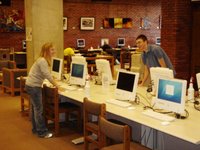The goal of the University Libraries’ are to be viewed as the best place for learning and discovery outside of the classroom. Our professionals and paraprofessionals — supported by student assistants and administrative personnel — are committed to providing programs, services, and collections that are strategic to each student’s academic success and each faculty member’s commitment to classroom instruction, research, and service. We are working hard to make the University Libraries a destination for research, learning, and friends.
Our students and faculty know that they can count on friendly help from our librarians to answer their reference questions and to help them with their research projects. They know, too, that the Libraries provide private and collaborative learning spaces, high technology for exploration and discovery, and strong digital and print resources for study and research. We are open 120.5 hours per week to accommodate student study patterns and faculty research habits.
During the 10-month period between July 1, 2005 through April 30, 2006, the University Libraries had many significant accomplishments. The complete list is available on our Website,
www.bsu.edu/library/article/0,,43179--,00.html. Below is an abbreviated listing:
General AchievementsBetween July 1, 2005 and April 30, 2006 the University Library’s turnstiles recorded 1,151,432 persons, an increase of 13,917 visits more than were recorded for the entire fiscal year 2004-2005. We anticipate a fiscal year turnstile count that exceeds 1,250,000 — which shows that students and faculty increasingly view the University Libraries as a destination.
- Extended Bracken Library service hours for the current academic year to 120.5 hours per week to accommodate student study patterns.
- In academic partnership with classroom faculty, reference librarians provided 784 library instruction sessions to 12,648 students.
- Focused on current research needs of students and faculty by answering 30,207 reference and research questions in-person meetings, email requests, and online chat services, representing a decrease of 9.9% over the previous year, and provided answers to 62,878 directional questions, an increase of 38.3% over the same period in the previous year.
- Introduced the Student Virtual Library page, a Web page designed to serve better the research and study needs of BSU’s undergraduates. Visit www.bsu.edu/library/svl
- Planned, created, and implemented the Services Excellence Working Group, a group created by the Dean of Libraries to conduct a continuing series of workshops entitled, “Customer Service 101” for the University Libraries’ student assistants.
- Increased membership in The Friends of the Alexander M. Bracken Library (FAMBL) to over 2,700 members who reside in most of the fifty states and forty other countries. This fiscal year, FAMBL donated approximately $25,000 in support of the University Libraries.
Digital Media Repository (DMR)For content acquisition and access management, greatly increased and expanded the DMR by collaborating with several academic units to develop specialty collections such as the Theatre Costume Collection, anatomical models digital collegian as teaching and instructional aids, and the Student Artwork Collection, among others. The number of digital objects now exceeds 50,000 items in formats such as slides, PDFs, photographs, audio and video files, drawings, paintings, etc. Visit http://libx.bsu.edu
Library Information Technology Services- Developed and implemented unique browser toolbars with links to University Libraries resources to use on library public stations and for installation on personal computers. Toolbars were developed for both Internet Explorer and FireFox browsers to provide easier access to web-based resources from the University Libraries.
Visit
www.bsu.edu/library/article/0,,42835--,00.html- Received a development license from DiMeMa for CONTENTdm, which allows the University Libraries to perform development work for the Digital Media Repository project without disrupting public access to CONTENTdm.
- Increased the number of PC public workstations to 347 units, including an additional 18 iMACs to support student use of technology in the Libraries for learning and discovery.
- Implemented RSS and blog technology on the University Libraries’ Homepage under the heading “News Gallery,” www.bsu.edu/library, to provide students, faculty, and others on-campus and off-campus about the University Libraries’ programs, services, and collections.
Technology Training Support Services- Hosted the Third Annual Faculty Technology Showcase, which featured 6 projects with 8 faculty members from 4 colleges in their use of information technology as a teaching tool.
- Offered Best Practices training program for the Faculty Enhancement Series, focusing on using software in the creation of websites, digital animated content, and multimedia.
- Introduced a faculty oriented newsletter, Tech Links. View the issues at
www.bsu.edu/techtrain/newsletterUniversity Copyright CenterCreated the Copyright for Students page to help students understand and apply copyright and intellectual property in their academic pursuits. Visit www.bsu.edu/library/collections/copyright/students
Archives and Special Collections Research CenterParticipated with Delaware County Historical Society, Muncie Public Library, Henry County Historical Society, the Dan Quayle Center and Vice-Presidential Museum, and University Libraries’ Archives and Special Collections in the planning and successful implementation of an Library Services and Technology Act (LSTA) grant-funded project to make selected East Central Indiana Civil War materials available through the Web for the benefit of educators and researches









